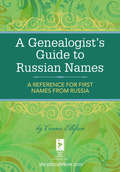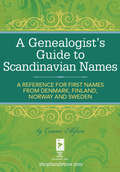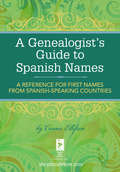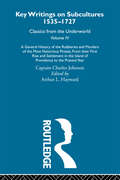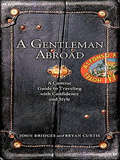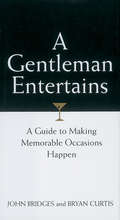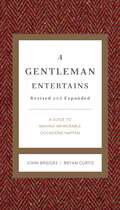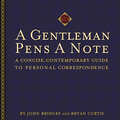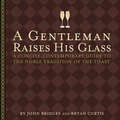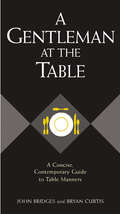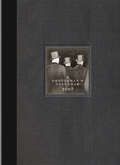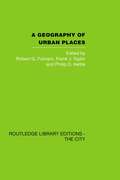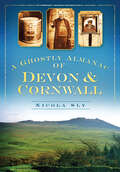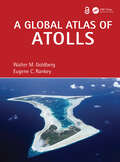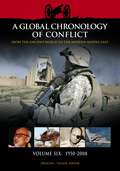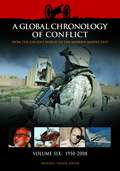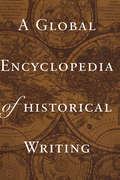- Table View
- List View
A Genealogist's Guide to Russian Names: A Reference for First Names from Russia
by Connie EllefsonGenealogists understand the value of a name and all the family history information names can provide. Now you can learn more about the Russian names in your family tree with this comprehensive guide. Discover the meaning of popular Russian names.You'll also find:Russian naming patterns and traditionsRussian emigration patternsA pronunciation guide
A Genealogist's Guide to Scandinavian Names: A Reference for First Names from Denmark, Finland, Norway and Sweden
by Connie EllefsonGenealogists understand the value of a name and all the family history information names can provide. Now you can learn more about the Scandinavian names in your family tree with this comprehensive guide. Discover the meaning of more than 1,000 Scandinavian names, including Danish names, Finnish names, Norwegian names and Swedish names.You'll also find:Naming patterns and traditions of Scandinavian countriesScandinavian emigration patternsA pronunciation guide
A Genealogist's Guide to Spanish Names: A Reference for First Names from Spanish-Speaking Countries
by Connie EllefsonGenealogists understand the value of a name and all the family history information names can provide. Now you can learn more about the Spanish names in your family tree with this comprehensive guide. Discover the meaning of popular Spanish names.You'll also find:Spanish naming patterns and traditionsSpanish emigration patternsA pronunciation guide
A General History of the Robberies and Murders of the Most Notorious Pirates - from their first rise and settlement in the Island of Providence to the present year: Previously published 1726 and 1927 (Key Writings On Subcultures, 1535-1727 Ser. #Vol. 3)
by Captain Charles JohnsonA General History of the Pirates has long been a classic of seafaring literature and was inspiration to both Robert Louis Stevenson and J.M. Barrie. Nothing is known about Captain Charles Johnson, and it is thought that the name may be assumed - there are even some who believe he may have been Daniel Defoe. All that can be stated with any certainty is that in 1724 a small octavo volume appeared that became so popular it grew through 4 editions over 2 years and is still famed today. Historians from both sides of the Atlantic have attested to the accuracy of the work's content. This is a reprint of the 1927 reissued 4th edition - enhanced by the Arthur L. Hayward's editorial touches.
A Gentleman Abroad
by Bryan Curtis John BridgesA Gentleman Abroad provides basic and helpful information for any man traveling to the 40 most popular foreign travel destinations in the world. In addition to aphorisms and sidebars that make the books in the GentleManners series unique, this book contains 40 chapters, one for each destination. Within each chapter will be almanac data, charts on average monthly temperature, foreign size charts for shopping, time differences, embassy information, basic foreign phrases, tipping customs, and other information that will allow a gentleman to navigate the city properly. Among the cities included are Rome, Paris, London, Tokyo, Hong Kong, Buenos Aires, Sydney, Amsterdam and Berlin.
A Gentleman Entertains
by Bryan Curtis John BridgesPractical and unpretentious, A Gentleman Entertains includes 15 essential preparations before entertaining 100 things every gentleman should know about being a host Ideas for twelve specific parties complete with more than 20 fool-proof recipes Tips on dealing with inevitable, inescapable, really ugly disaster moments.
A Gentleman Entertains Revised & Updated: A Guide to Making Memorable Occasions Happen (The GentleManners Series)
by Bryan Curtis John BridgesHere's a thought. Entertainingisn't just something that happens when the ladies decide to break out the goodchina. Any gentleman who enjoys the company of friends, a delicious meal, or agreat drink should know how to host a gathering. So shove those frozen burritosout of the way and make some room in the freezer for your stainless steel icebucket. It's time to entertain. John Bridges and Bryan Curtis have mapped out everything youneed to know for any occasion, from dinner parties to tailgate potlucks.Whether you're hosting clients for a business lunch at an upscale restaurant orcorralling your rowdy friends for a weekend cookout, these are the fundamentalsyou'll need to ensure you and your guests have a memorable time. The details have been wrangled outalready--all that's left is for you to sit back and enjoy the company of yourfavorite people.
A Gentleman Gets Dressed Up Revised & Updated: What to Wear, When to Wear It, How to Wear It (The GentleManners Series)
by Bryan Curtis John BridgesLet's get one thing straight. Clothes do not make the man .. . but they do make a difference. And regardless of whether we like the ideaof appearances driving impressions, a man's exterior often is perceived as an indicatorof what's happening on the interior.Fortunately, tasteful and appropriate dressing doesn'trequire inordinate amounts of time or money. Any man can hit the door in fine shapewith only a little forethought and a bit of attention to a few guidelines.Never mind the heady cologne and designer labels. With a navy blazer, a goodbar of soap, and a regular haircut regimen, he'll be well on his way to becomingthe guy who knows exactly how to suit up, regardless of the occasion. Most important,A Gentleman Gets Dressed Up illustrateshow a man's natural confidence and personality are the best foundation for anywardrobe.
A Gentleman Pens a Note: A Concise, Contemporary Guide to Personal Correspondence (Gentlemanners)
by Bryan Curtis John BridgesA gentleman knows the importance of effectively expressing, in three or four sentences, his thanks for a gift or for a job interview, conveying his sympathy, or saying he is sorry. A Gentleman Pens a Note takes away the fear and discomfort a man experiences when faced with the task of writing a note by giving instruction and example in the proven style of the other GentleManners books.A Gentleman Pens a Note contains examples of more than 40 different handwritten notes, as well as sentences to avoid. It also includes aphorisms and sidebars on subjects such as stationery, pens, and pre-printed notes.A gentleman does not expect a response when he has sent a thank-you note (or even a thank-you gift).A gentleman knows that words such as "Thank You," "Congratulations," or "With sympathy," will mean a great deal more written in his own hand than when gold-embossed by a printer.
A Gentleman Raises His Glass: A Concise, Contemporary Guide to the Noble Tradition of the Toast
by Bryan Curtis John BridgesA concise guide to giving meaningful, appropriate toasts for virtually any occasion, from the author of How to Be a Gentleman.A Gentleman Raises His Glass teaches how to prepare a toast for virtually any occasion—be it a wedding, a celebratory dinner, or any social celebration where a tribute would be welcome. It also tells the history of the toast, gives examples of the right and wrong things to say, and contains more than fifty aphorisms on toasting:A gentleman knows that, unless he is seated in a crowded public restaurant, he must stand to deliver a toastWhen a gentleman makes a toast, he makes it directly to his guest of honor, not to the table at largeA gentleman knows that a toast, even at a bachelor’s dinner, is still intended to be a tribute—not an embarrassment
A Gentleman Walks Down the Aisle
by Bryan Curtis John BridgesHe may not have been dreaming of this magical day since childhood, but a groom's role in his wedding is as important as his bride's. This guide will shape even the most baffled groom into a well-mannered gentleman, from engagement party to reception and every blessed event in between. Authors John Bridges and Bryan Curtis even offer advice for every male member of the wedding party. Fathers, groomsmen, ring bearers, and guests, take note! Bridges and Curtis have included everything a gentleman should know to skillfully assume his role at a wedding.He will learn:How not to proposeThe truth about bachelor partiesWho pays for whatTips for a pitch-perfect toastHow to calm an indignant mother-in-lawWhen to stay quiet and when to speak upDozens of phrases a gentleman should never utterWhat to wear and when to wear itThe secret to a perfect thank-you noteDon't let the blur of tux fittings, place settings, family gatherings, and monogramming overwhelm the simple objective of a wedding. A Gentleman Walks Down the Aisle will help him understand the delicate art of being a man on one of life's most important days.The groom and his fellow gentlemen may find themselves left to their own devices as the wedding day approaches, but their role is every bit as important as arranging the flowers or selecting the font for the wedding invitations. For the groom, the fathers of the bride and groom, the best man, the groom's attendants, and even the gentleman who participates in the celebration merely as a guest, this book explains what to do, where to stand, what to wear, and what to say.
A Gentleman at the Table: A Concise, Contemporary Guide to Table Manners (Gentlemanners)
by Bryan Curtis John BridgesGain the knowledge you need to maneuver any dining situation - from a casual meal of fried chicken at mom's house to a seven-course dinner at the finest restaurant in the world.A Gentleman at the Table will give any man the knowledge he needs to maneuver any dining situation - from a casual meal of fried chicken at his mom's house to a seven-course dinner at the finest restaurant in the world. It includes. . .How to set a tableHow to pronounce more than 100 unusual food namesHow to use obscure eating utensilsHow to perform the Heimlich maneuverHow to eat more than 25 foods that are challenging to eat gracefully such as lobster, snails, fried chicken, and pasta.In a society where more and more people eat with plastic forks and spoons at fast food restaurants, it is still important that a man know proper dining etiquette. There are still situations where not knowing what a finger bowl is or not knowing how to pronounce an item on a menu can have an effect on what others think of you. Showing he has little working knowledge of table manners at a lunch meeting or on a job interview over dinner may have an important impact on a man's life.Like all the books in the GentleManners series, A Gentleman at the Table is easy to use, non-threatening, and an entertaining read.
A Gentleman's Calendar 2007
by Bryan Curtis John BridgesThis handsome calendar showcases aphorisms for each day of the week from the successful selling GentleManners books. Inside, two dates per page with a three-day weekend page display the week's appointments. Monthly dividers are sturdy, tabbed, feature the full month on the front, and on the back, feature month-appropriate sidebars that will educate readers. á
A Gentleman's Calendar 2007
by Bryan Curtis John BridgesThis handsome calendar showcases aphorisms for each day of the week from the successful selling GentleManners books. Inside, two dates per page with a three-day weekend page display the week's appointments. Monthly dividers are sturdy, tabbed, feature the full month on the front, and on the back, feature month-appropriate sidebars that will educate readers.
A Geography of Urban Places (Routledge Library Editions)
by Robert G. Putnam Frank J. Taylor Philip G. KettleThis book presents a selection of readings to present varied opinions, approaches and reports from various international professional journals. Among the journals represented are: Regional Science Association Journal, The Canadian Geographer, The Annals of the American Association of Geographers, Economic Geography, Landscape, Journal of Soil and Water Conservation and Land Economics. This book was first published in 1970.
A Ghostly Almanac of Devon and Cornwall
by Nicola SlyA Ghostly Almanac of Devon & Cornwall is a month-by-month catalogue of reported spectral sightings and paranormal phenomena from around the South West of England. Contained within the pages of this book are strange tales of restless spirits appearing in streets, buildings and churchyards across the region, including a haunted German U-Boat wrecked off Padstow during the First World War; the 'Grey Lady' at the Royal Devon and Exeter Hospital, so-named because of her grey nurse's uniform; the ghost of a Dartmoor Prison inmate seen herding sheep in the prison grounds and out on the moor itself; a shade with a penchant for horror films at Plymouth's Reel Cinema; and the infamous 'Hairy Hands of Dartmoor', which forces drivers off the road. Richly illustrated with 100 photographs and postcards, this chilling collection of stories will appeal to everyone with an interest in the West Country's haunted heritage, and is guaranteed to make your blood run cold.
A Girl Called Jack: 100 delicious budget recipes
by Jack Monroe100 simple, budge and basic-ingredient recipes from the bestselling and award-winning food writer and anti-poverty campaigner behind TIN CAN COOK 'A terrific resource for anyone trying to cook nutritious and tasty food on a tight budget' Sunday Times______ Learn how to utilise cupboard staples and fresh ingredients in this accessible collection of low-budget, delicious family recipes. When Jack found themselves with a shopping budget of just £10 a week to feed themselves and their young son, they addressed the situation with immense resourcefulness and creativity by embracing their local supermarket's 'basics' range.They created recipe after recipe of delicious, simple and upbeat meals that were outrageously cheap, including: · Vegetable Masala Curry for 30p a portion · Jam Sponge reminiscent of school days for 23p a portion · Onion Pasta with Parsley and Red Wine - an easy way to get some veg in you · Carrot, Cumin and Kidney Bean Soup - tasty protein-packed goodness In A Girl Called Jack, learn how to save money on your weekly shop whilst being less wasteful and creating inexpensive, tasty food.______ Praise for Jack Monroe: 'Jack's recipes have come like a breath of fresh air in the cookery world' NIGEL SLATER 'A terrific resource for anyone trying to cook nutritious and tasty food on a tight budget' Sunday Times 'A plain-speaking, practical austerity cooking guide - healthy, tasty and varied' Guardian 'A powerful new voice in British food' Observer 'Packed with inexpensive, delicious ideas to feed a family for less' Woman and Home
A Global Atlas of Atolls
by Walter M. Goldberg Eugene C. RankeyScattered like dots rising from the deep across vast expanses of the world’s tropical and subtropical oceans, atolls with their turquoise lagoons and reefs teeming with colorful marine life have captured the public imagination. They have also been the homeland of millions of people for millennia as various groups of migrants spread across the far reaches if the Pacific, Indian and Western Atlantic regions. Developed from recently available satellite data, A Global Atlas of Atolls presents high-quality details of 476 atolls across the globe, characterizing aspects of the atoll rim, the lagoon, and their coral reef communities in unprecedented detail. In synthesizing and enhancing understanding of these unique seascapes, this volume provides a distinct compendium of descriptions and images, as well as documentation of the environmental conditions of winds, waves, and tides and a summary of the background literature for each atoll area. There is no comparable work.After an introduction that includes a glossary of terms, each atoll is documented in the form of an atlas written for scientists, but accessible to any diver or reader interested in these spectacular reef-island habitats. This book also describes some current challenges and perspectives on their future. It will be useful as a reference work for marine scientists, while providing a minimum of technical jargon for those who are not scientists, but who enjoy reading about exotic places with unusual attributes.Chapter 3 of this book is freely available as a downloadable Open Access PDF at http://www.taylorfrancis.com under a Creative Commons [Attribution-Non Commercial-No Derivatives (CC-BY-NC-ND)] 4.0 license.
A Global Chronology of Conflict: Volume 1, 3000 BCE–1499 CE
by Spencer TuckerFrom the heroic stand of the 300 Spartans at Thermopylae and the brutally efficient conquests of Genghis Khan's Mongol hordes, to the rain of arrows at Agincourt and the blood-stained hills around Gettysburg, this compelling work chronicles the history of conflict in all its guts and glory.
A Global Chronology of Conflict: Volume 2, 1500-1774
by Spencer TuckerNow from ABC-CLIO, long regarded as a premier publisher of military history, comes a monumental resource that encapsulates the entire scope of conflict among human societies. Spanning nearly five millennia, from the earliest documented fighting to the present, A Global Chronology of Conflict: From the Ancient World to the Modern Middle East, provides a comprehensive survey of major military events. With coverage that reaches beyond the battles, this work examines the political and diplomatic forces driving world conflicts, revolutions, forced changes of governments, international treaties, and acts of aggression and terrorism.
A Global Chronology of Conflict: Volume 3, 1775-1860
by Spencer TuckerNow from ABC-CLIO, long regarded as a premier publisher of military history, comes a monumental resource that encapsulates the entire scope of conflict among human societies. Spanning nearly five millennia, from the earliest documented fighting to the present, A Global Chronology of Conflict: From the Ancient World to the Modern Middle East , provides a comprehensive survey of major military events. With coverage that reaches beyond the battles, this work examines the political and diplomatic forces driving world conflicts, revolutions, forced changes of governments, international treaties, and acts of aggression and terrorism.Written by acclaimed military historian Spencer C. Tucker, these six chronologically organized volumes offer an accessible, richly detailed timeline of military conflict across human history. The concise entries cover all important events on the battlefield and in the corridors of power, with special features highlighting hundreds of key leaders and weapon systems. From specific data on casualties to coverage of evolving weapons technology to insightful analyses of the social impact of war, A Global Chronology of Conflict is an essential resource for students, researchers, history buffs, and general readers alike.
A Global Chronology of Conflict: Volume 4, 1861-1918
by Spencer TuckerNow from ABC-CLIO, long regarded as a premier publisher of military history, comes a monumental resource that encapsulates the entire scope of conflict among human societies. Spanning nearly five millennia, from the earliest documented fighting to the present, A Global Chronology of Conflict: From the Ancient World to the Modern Middle East, provides a comprehensive survey of major military events. With coverage that reaches beyond the battles, this work examines the political and diplomatic forces driving world conflicts, revolutions, forced changes of governments, international treaties, and acts of aggression and terrorism.
A Global Chronology of Conflict: Volume 5, 1919-1949
by Spencer TuckerThis six-volume reference (1. 5 million words) constitutes a seemingly monumental enterprise for one person, that one person being a meticulous expert who didn't confine himself to a simple chronology but instead expanded the project to encompass plenty of contextual and supplementary material. Tucker is a former army captain and intelligence analyst who served in the Pentagon during the Vietnam War and subsequently taught military history for decades at Texas Christian University and at Virginia Military Institute before retiring in 2003. Undaunted by the task at hand, he presents a year-by-year, event-by-event chronology, having made a set of criteria and guidelines for selection and presentation (these are explained in his preface). The volumes include, also, a total of 376 biographical profiles and 301 key innovations and technologies--weapons that changed history, as well as some 250 detailed descriptions of key battles throughout history, and a couple hundred maps. Each volume includes the comprehensive index.
A Global Chronology of Conflict: Volume 6, 1950-2008
by Spencer TuckerNow from ABC-CLIO, long regarded as a premier publisher of military history, comes a monumental resource that encapsulates the entire scope of conflict among human societies. Spanning nearly five millennia, from the earliest documented fighting to the present, A Global Chronology of Conflict: From the Ancient World to the Modern Middle East provides a comprehensive survey of major military events. With coverage that reaches beyond the battles, this work examines the political and diplomatic forces driving world conflicts, revolutions, forced changes of governments, international treaties, and acts of aggression and terrorism. Written by acclaimed military historian Spencer C. Tucker, these six chronologically organized volumes offer an accessible, richly detailed timeline of military conflict across human history. The concise entries cover all important events on the battlefield and in the corridors of power, with special features highlighting hundreds of key leaders and weapon systems. From specific data on casualties to coverage of evolving weapons technology to insightful analyses of the social impact of war, A Global Chronology of Conflict is an essential resource for students, researchers, history buffs, and general readers alike.
A Global Encyclopedia of Historical Writing (Garland Reference Library Of The Humanities)
by D. R. WoolfFirst published in 1998. Routledge is an imprint of Taylor & Francis, an informa company.
